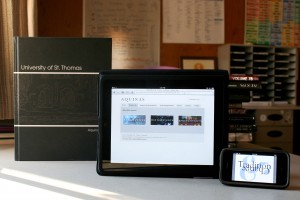Since 1918 St. Thomas has been printing a yearbook, immortalizing faces of students and faculty on glossy pages to be flipped through in the years to come – until last year.

In the 2010-11 school year, the Aquinas yearbook went digital with a website version accessible to anyone with an Internet connection.
Now, the Aquinas is making another transition to a digital magazine format, as well as creating a free application available for those who own smartphones and iPads.
Mark Rapacz was hired as the Aquinas adviser after the switch to online-only yearbooks was made, but he believes one big reason for the changes is accessibility.
“With print, you’re limited by numbers and cost,” Rapacz said. “With digital media … it’s appealing to a broader public.”
He believes the digital format also allows for more creative freedom, as well as the chance to embed video, audio and photo slideshows, which was impossible in print.
Rapacz added it’s about “being a little more innovative” as the culture shifts more towards digital publishing and e-books.
The Aquinas will release a winter preview of the digital magazine yearbook version in mid-February and a full version, as well as the app, in the spring.
Sophomore Alex Rollins, lead photographer for the Aquinas, believes that the website version launched last year was just a transition.
“(It was) sort of an awkward spot going from having a book to having a little bit of an awkward website to what we’re going to try to do now,” Rollins said.
The Aquinas staff’s main goal is to make the digital version of the yearbook still feel somewhat like the actual book version students have had all their lives.
With the app, Rapacz said students will “still get the tactile function of being able to flip the pages.”
But of course, a digital version of the yearbook that feels like a book will never be the same as the real thing.
“I think (the digital version) is nonsense because the yearbook is supposed to be a book and not online,” junior Marquita Borst said. “I personally wouldn’t look at a yearbook online because that would take too much time, rather than having it in front of my face.”
Sophomore Emily Hoffmann said she also likes to sit down with an actual book.
“I remember even just this past year looking at old yearbooks with my mom and my sister and just being able to sit on the couch together and flip through the pages…I think that some of that is lost on the digital,” Hoffmann said.
Sophomore Kale Siebert discusses the new changes to the yearbook. (Rita Kovtun/TommieMedia)
Rollins understands many people’s reactions to the new changes. He said at the staff’s first meeting an old yearbook was passed around “just to smell it.”
“You can’t get that with a PDF. You can’t get that online,” Rollins said. “I totally understand (the) different sentiment about not having a book.”
Freshman Amanda Branch, section editor for the Aquinas, shares a similar view.
“I’ll miss and everyone will miss an actual hard copy and being able to turn the pages,” she said.
Senior Nick Tuttle is one student that has a more positive outlook on the new version and recognizes the more innovative approach.
“The hard copy version is more like a high school event; in college I guess it’s not really like that,” he said. “It’s accessible to more people (and) accessibility is a plus.”
Hoffmann sees the other side also. She said there’s “an element of going green and just being conservative, which I think is really great.”
Even with the mixed reactions, many students admit they will attempt to try the new digital magazine and app versions of the yearbook.
“Now that I know it’s online, I’ll definitely check it out,” Tuttle said. “I have no excuse not to look at it now that it’s everywhere, (even) in my pocket on my phone.”
Others, such as Hoffmann, will only use it in certain situations.
“The only reason I would check it out would be if I was hanging out with some friends (and we) scrolled through it together,” Hoffmann said.
Branch points out that the app can make the yearbook into something useful for everyday life.
“Now you can use it to look people up or look at what happened last year if you’re trying to come up with ideas for your club,” Branch said.
Ultimately, Branch hopes that “people will give it a chance and attempt to check it out because we all work really hard on it.”
“It’s going to be an experiment,” Rapacz said. “We’re forging ahead, and hopefully we can do a good job even though this is our first time trying it.”
Rita Kovtun can be reached at kovt1547@stthomas.edu.

Why can’t they do both? Everyone loves the physical book version so much; so why then can’t they do both?